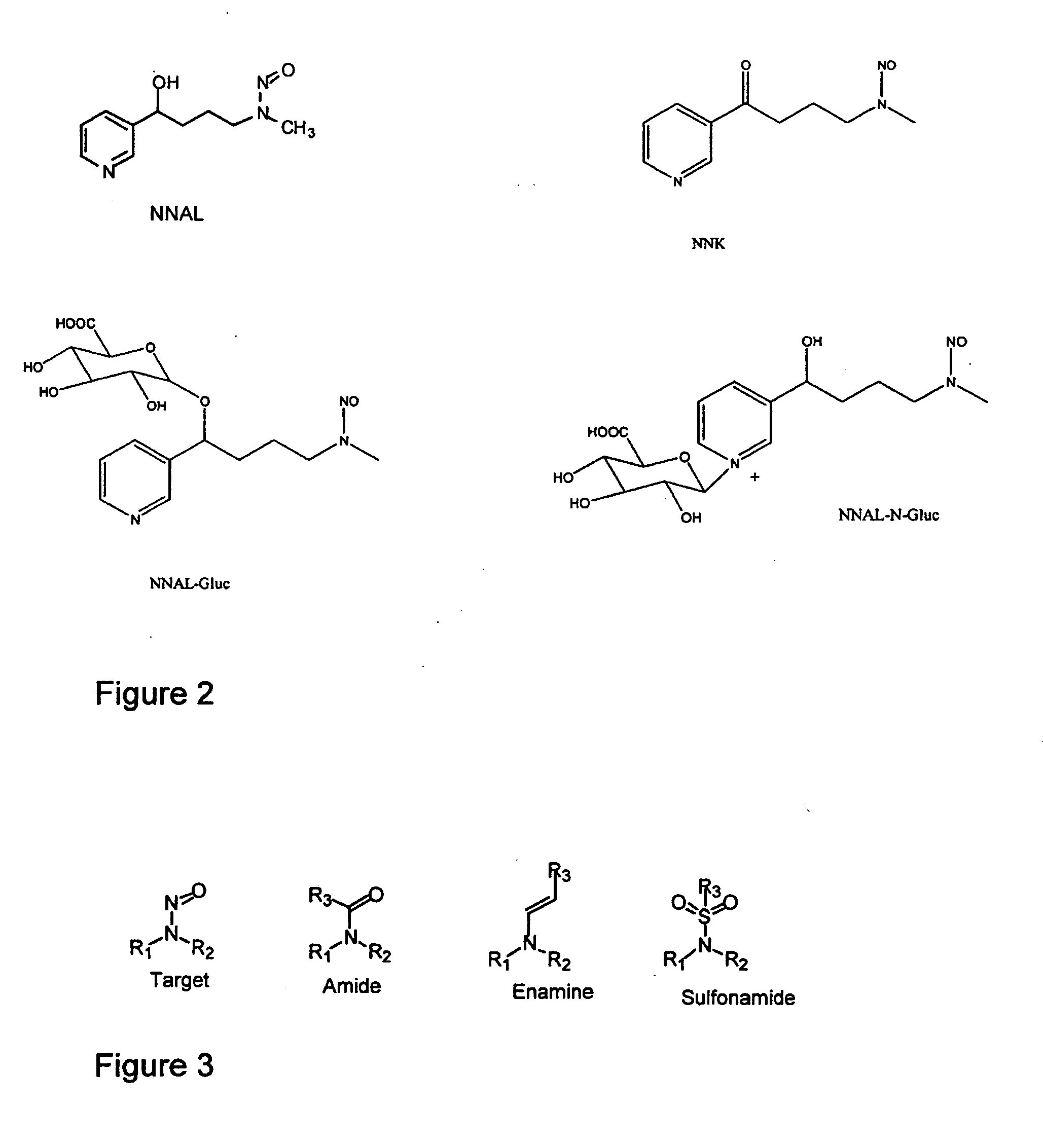Molecularly imprinted polymers selective for nitrosamines and methods of using the same
a technology of imprinting polymers and nitrosamines, applied in the direction of tobacco, tobacco treatment, separation processes, etc., can solve the problems of large number of samples generated when screening the general population, errors in estimation of original sample concentrations, and lack of robustness, sensitivity and speed required for a large number of samples to be processed. to achieve the effect of reducing the exposure to
- Summary
- Abstract
- Description
- Claims
- Application Information
AI Technical Summary
Benefits of technology
Problems solved by technology
Method used
Image
Examples
example 1
Synthesis of Enamine Template (MPAPB)
[0072] Anhydrous toluene (freshly dried over sodium) 2 ml was added to a vial containing 4-methylamine-1-(3-pyridyl)-1-butanol (100 mg). 500 mg freshly dried Molecular sieve was added to it. The mixture was stirred for 1 hour under N2. To the mixture 100 μl propionaldehyde was added. The mixture was stirred at 55° C. for 4 hours. The reaction was monitored by HPLC after 1.5 hours. The color of the product was orange-yellow in toluene. The crude product in toluene was directly used for the synthesis of the MIP after filtration without purification. Template MPAPB yield was around 90%.
example 2
Synthesis of MIP Using Pyridine Carbinol as Template
[0073] To pyridine methanol (97 μl) 3.74 ml of purified TRIM (purified over basic alumina), functional monomer MAA (1020 μl), porogenic solvent toluene (7.1 ml) and finally initiator ABDV (63 mg) were added and stirred until a clear solution was obtained. The solution was transferred to a glass vial, purged with nitrogen for 5 minutes and flame sealed. Heat induced polymerization was carried out at 45° C. for 24 hours. The polymer mixture was then cured at 70° C. for a further 24 hours.
[0074] Processing of the crude MIP material was as follows: the MIP was coarsely crushed and transferred to a Soxhlet thimble. It was extensively washed first with methanol for 12 hours and then with acetic acid for 12 hours in order to remove any remaining template and other non-reacted monomers. After these first extraction steps, the polymer was vacuum dried and then ground and sieved to a fine powder within a size range of 20 to 90 μm. As a fin...
example 3
Use of MIPs as Selective Sorbents in SPE
[0075] In one embodiment of the invention, the MIP can be packed into solid phase extraction columns for the selective extraction of NNAL from a biological matrix. First, a polypropylene frit was placed in an appropriate SPE column (typically 10 ml capacity for analytical uses), 25 mg of the MIP was then added on top to form a MIP bed and the second frit was firmly pressed onto the surface of the MIP bed. Conditioning of the column was carried out in the following order: 1 ml DCM, 1 ml MeOH and finally 1 ml distilled water were added to the MIPSPE.
[0076] The sample, e.g. human urine (5 mL) containing low amounts of the analyte was allowed to pass through the conditioned MIPSPE column. The column was then subjected to vacuum in order to remove the water until the material was dry. Then, polar interfering substances that may have non-specifically associated with the MIP were eluted by a wash with 1 ml distilled water. Again, a drying step usin...
PUM
| Property | Measurement | Unit |
|---|---|---|
| Temperature | aaaaa | aaaaa |
| Acidity | aaaaa | aaaaa |
| Selectivity | aaaaa | aaaaa |
Abstract
Description
Claims
Application Information
 Login to View More
Login to View More - R&D
- Intellectual Property
- Life Sciences
- Materials
- Tech Scout
- Unparalleled Data Quality
- Higher Quality Content
- 60% Fewer Hallucinations
Browse by: Latest US Patents, China's latest patents, Technical Efficacy Thesaurus, Application Domain, Technology Topic, Popular Technical Reports.
© 2025 PatSnap. All rights reserved.Legal|Privacy policy|Modern Slavery Act Transparency Statement|Sitemap|About US| Contact US: help@patsnap.com



